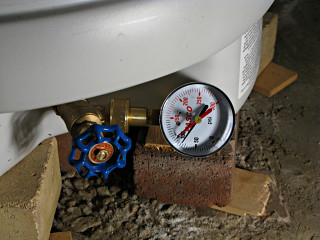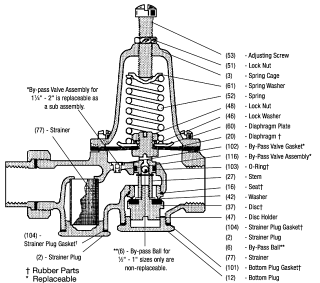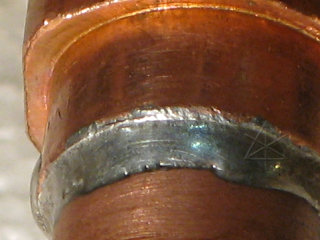
As expected, 85 or 90 PSI right off, and even though the town system wasn't in a backflow cycle at the time I saw it varying quite a bit, and soon while I watched it peaked slightly over 100. Wow.
|
After observing the little leak-detector widget on the water meter spinning
randomly forward and backward, I called the town water department to bounce
some ideas off them. For one thing, I wanted to make sure this behavior
wasn't going to rack up a bunch of gallons I never actually used.
A little situational explanation is in order. My neighborhood is a short distance up the street from one of the main pump houses -- in fact, I sit on the other side of where the pump-house tees into the mains such that it is between me and the line to the storage tanks. Town well water has to pass through a whole bunch of filtering, and given all the iron, oak tannin, and other spoo that may seep down as far as the water table the filters need to be purged on a fairly regular basis. This, in fact, happens about twice a day in the mornings and evenings. This is done by backflowing the filters and sending the results to a big settling tank outside the building, which has to get pumped out a couple of times a year. The backflow causes pressure variations on the facility's output. The town guy also pointed out that the main pressure at my altitude is likely to be in the neighborhood of 90 PSI which *is* considered rather high for normal residential service. In some municipalities, the LEGAL limit is 80 at any point in the system. Thus, the water coming into my house is subject to fairly severe ups and downs in pressure sometimes. In fact this has been going on for years, with one noticeable symptom that the toilet valve would suddenly push open and run a little bit, in a fairly noisy fashion. And I'd see the faucet flow rise and fall if I was using the water at the time. So this was a known quantity, a normal part of living here. I hadn't thought too much about it, but after seeing the water heater fittings rise out of the top of the housing like they did and a few other demonstrations of the effects of water pressure, I began to get *really* paranoid. Well, I've always been a little paranoid about this, opting to turn off the main feed whenever I'd be away for any extended time, but mostly to make sure a freezeup wouldn't totally flood the basement if the heater should quit for some reason. But the water system had never had any sort of check valve or regulation, it was just the utility straight into all my fixtures. And evidently, back out. The amount of flow was clearly being assisted by the fact that the new water heater was much more like a big stretchy bag than the old one. |

|
So just how much pressure was it? Well, clearly it was something to measure.
Google told me that I could get a simple test gauge at
F.W.Webb in the next
town over, so I did that. This screws quickly onto any hose bibb or threaded
faucet like the laundry supply or, conveniently enough, the drain cock on the
water heater. It has a "dead hand" to record the highest pressure seen by
the live one while the system is under observation.
As expected, 85 or 90 PSI right off, and even though the town system wasn't in a backflow cycle at the time I saw it varying quite a bit, and soon while I watched it peaked slightly over 100. Wow. |

| Clearly, and several friends I discussed it with agreed, I needed one of these. |
|
(Taken from this PDF, as
listed here.
Many more helpful documents about pressure reduction, expansion valves, plumbing, boiler fittings, etc are available at the Watts Regulator website.) |
| I took the opportunity to fashion a better hanger block for the feed continuing to the rest of the house -- it had been basically just hanging off the sillcock "T" and a nearby joist X-brace all those years. This would bring the new endpoint into perfect position for the flex hose. |

| Ah, the magic of capillary action! Sweating this joint involved solder flowing *upward*, which it appeared to do quite handily once the parts were hot enough. I still find this amazing. |
|
I refilled the system and checked the pressure gauge. Right up to the
factory-preset 50 PSI, and over the next week it never went above that. All
the fixtures in the house work so much more *smoothly* now, since they're
now holding back about half the pressure they once were, but at the same time
there's no loss in reasonable flow capacity. Much less turbulence. When the
regulator is doing its thing it emits a quiet hiss, as the disk valve inside
undoubtedly makes a narrow slit for the water to flow through and all the
high-pressure turbulence happens in there instead.
And I haven't heard anything from the toilet since. The regulator also more or less acts as a check valve, preventing backflow into the utility, bringing the immediate concern about thermal expansion pressure. As of the completion of this, there were three means of pressure relief in the system with varying capacities and thresholds:
|